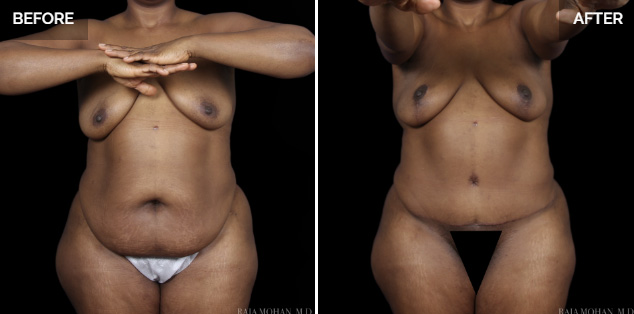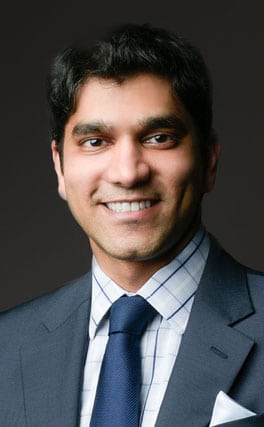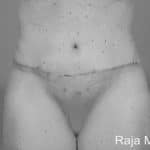More than 125,000 patients undergo Tummy Tuck each year. Variations exist but the procedure is largely standardized. Dr. Raj’s patients are guided along each step from the initial consultation through the procedure and into recovery.
As with any kind of surgery, has inherent risks and complications. As with any medical procedure, it’s a good idea for patients to ask their physician any questions they might have before choosing to undergo surgery.
Table of Contents
- What is a Tummy Tuck
- Tummy Tuck Before and After
- Candidate for a tummy tuck
- Types of Tummy Tucks
- Tummy Tuck consultation
- Tummy Tuck procedure
- Recovery
- Risks and complications
- Tummy Tuck Cost
- Questions and Answers
- Book Consult
What is a Tummy Tuck?
In many people the effects of age, pregnancy or weight loss can stretch the skin, abdominal tissue and muscles, and getting a flat, firm abdomen isn’t always possible with diet and exercise alone. People with these issues may be candidates for a tummy tuck.
The abdominoplasty a procedure meant to improve the contour of the abdomen and mid-section. This procedure works by removing excess skin and abdominal tissue, in some cases in conjunction with liposuction to remove excess fat in the flanks, abdomen, or back. The process also tightens the abdominal muscles and transposes the belly button (umbilicus to a new position). The goal of the procedure is a flatter, slimmer abdomen.
Tummy Tuck Before and After

Who is a candidate for a tummy tuck?
Patients who are candidates for a abdominoplasty primarily firstly should be in good overall mental and physical health and have realistic expectations for cosmetic surgery. A abdominoplasty is not a weight loss procedure. It helps if patients are at or near their ideal weight and not planning to or able to get pregnant, as fluctuations in weight can undo the effects of surgery.
Finally, patients should exhibit symptoms of loose skin or separated abdominal muscles which could be repaired by the procedure.
Fact: A abdominoplasty can be performed alongside breast procedures like breast augmentation, breast lift, breast reduction, commonly known as a mommy makeover.
Tummy Tuck Results Video
Types of Tummy Tucks: Options and Variations
There are two main types of abdominoplasty procedure, Mini and Full:
Mini Tummy Tuck
Mini tummy tucks are reserved for patients with a small amount of excess skin in the lower abdomen, as no surgical work is performed above the navel.
Traditional Extended Tummy Tuck (Full Tummy Tuck)
A traditional, or full abdominoplasty involves a longer incision but also tightens the muscles and relocates the belly button (umbilicus).
This is the most common type of abdominoplasty. The six pack muscles or rectus abdominus muscles may also be tightened with sutures as part of the procedure.
The results of the physical examination during the initial consultation will determine which procedure the patient is a candidate for.
Why Choose Dr. Raja Mohan?
Patients choose Dr. Raj for a variety of reasons. He is a board-certified plastic surgeon with professional association memberships in good standing. He is known for being personable and warm, and for not just providing excellent patient care – but really caring about his patients. Ultimately though, it’s not his continued leadership in the field, his ongoing publication and research, or his warmth and charisma that positions Dr. Raj as one of Dallas’ best plastic surgeons. It’s the results that speak the loudest.Dr. Raj Mohan is a board-certified, aesthetic-fellowship-trained plastic surgeon.





The Initial Consultation
During the initial consultation patients will meet with Dr. Raj and his staff, and a thorough medical history and physical will be conducted to ensure that the patient might safely undergo plastic surgery. Detailed measurements are taken, and Dr. Raj and the patient will discuss their goals to find out if abdominoplasty is the right choice. The procedure itself is described in detail and the overall process is outlines. Ideal outcomes and possible pitfalls are discussed, and the patient is given an opportunity to have their questions answered before scheduling surgery.
The Procedure
Before the procedure
Before the procedure, patients are given clear instructions on how to prepare for the procedure and what medications to avoid. Patients may need pre-operative testing to be completed. Some patients may need medical clearance from their primary care physician. Typically, patients who are healthy and are non-smokers are good candidates for abdominoplasty. Dr. Raj and his team will provide instructions and training in scar reduction techniques will help to minimize the scarring, as well as providing detailed instructions for after-care.
The day of the procedure
The patient will arrive at the accredited surgery center or hospital and be greeted by Dr. Raj’s staff. Prior to the procedure Dr. Raj will perform a marking and discuss the details of surgery in the pre-operative holding area. This provides a final opportunity for Dr. Raj to answer any questions before the patient is placed under anesthesia and the surgery commences in an operating room.
In the Operating Room
While there are variations on the procedure, most abdominoplasty patients are candidates for traditional abdominoplasty surgery. Abdominoplasty is performed in an operating room under general anesthesia as an outpatient procedure for patient comfort and safety.
During the procedure:
Dr Raj will make a horizontally oriented incision between the pubic hairline and the belly button
Once the skin is lifted, the underlying muscles are reinforced and repaired.
A second incision is made above the navel to remove excess skin there and prepare for placement of the belly button.
The upper abdominal skin is pulled down like a movie screen. The excess skin is trimmed, and the remaining tissue is sutured together.
A new opening for the belly button is then created and the navel is sutured into position.
Sutures, skin adhesives, tapes or clips close any remaining skin incisions.
In most cases, the procedure takes between two and four hours.
Recovery
 Most patients will be released home after spending some time recovering from the anesthesia with instructions for aftercare. Abdominoplasties performed by Dr. Raj all use dissolvable sutures which do not require removal. The main thing the patient must do during the post-operative period is always keep the wounds clean and wear a compression garment to help reduce bruising and swelling. While patients are encouraged to walk around and resume a normal diet as soon as the evening after surgery, they will need to wear the compression garment and avoid strenuous activity for up to 6 weeks before resuming full normal activities.
Most patients will be released home after spending some time recovering from the anesthesia with instructions for aftercare. Abdominoplasties performed by Dr. Raj all use dissolvable sutures which do not require removal. The main thing the patient must do during the post-operative period is always keep the wounds clean and wear a compression garment to help reduce bruising and swelling. While patients are encouraged to walk around and resume a normal diet as soon as the evening after surgery, they will need to wear the compression garment and avoid strenuous activity for up to 6 weeks before resuming full normal activities.
Limitations, Risks, and Possible Complications
Like any other type of major surgery, a abdominoplasty has some possible risks including discomfort, bruising, swelling, numbness, and infection. Some patients are sensitive to anesthesia and may have an allergic reaction. Additionally, bleeding, accumulation of fluid, delayed healing and the formation of blood clots are possible complications of abdominoplasty. Patient medical history may impact the likelihood of these complications.
Dr. Raj will cover potential risks in detail before the procedure.
Tummy Tuck Cost Dallas
The ASPS (American Society of Plastic Surgeons) estimates the average Dallas tummy tuck cost to be around $6,000 to $7,000. This is only a foundational price, however. It does not include hospital fees, anesthesia expenses, or out-of-pocket costs.
Of course, the cost of a tummy tuck in Dallas will typically be higher for geographical reasons as well. As is the case with other serious medical procedures, when tummy tuck surgery is performed in a larger city like Dallas, the cost is typically higher.
Cost Considerations
The cost Dallas TX residents usually pay will also be influenced by the following:
- Your Surgeon’s Expertise: Plastic surgeons with more experience and training tend to charge more. Even though this means the tummy tuck cost Dallas patients will pay may be higher, it is ultimately beneficial to patients as they’ll be able to expect better care and optimal results.
- Where You Get Surgery: Hospitals and other surgical facilities will bill you for the use of their staff, operating room, recovery room, and equipment.
- Pre- and Post-Operative Costs: Some patients need tests (labs, EKGs, etc.) before surgery. You’ll also be responsible for buying wound care supplies, post-operative compression garments, and prescribed medications after surgery.
If you have additional questions about pricing, such as those regarding mommy makeovers or the typical mini tummy tuck cost Dallas residents should expect, please schedule a consultation with Dr. Mohan.
FAQ
Traditionally the first few days after abdominoplasty are quite painful, especially in areas where muscle repair is performed. Dr. Raj uses a specialized local anesthetic, such as Exparel, to provide a long acting buffer against pain during the initial healing stages. By injecting the anesthetic into the muscle repair sites and surrounding skin overall pain from the procedure is greatly reduced during the early healing stage and patients can look forward to an easier recovery process. As an added benefit the use of these long-acting anesthetics reduces the amount of narcotic medication required.
Within 24 hours after the procedure patients can resume walking and most normal activities, returning to work in as little as 7-10 days.
It is recommended patients are at their goal weight at the time of a tummy tuck. Losing too much weight after surgery can result in loose skin which defeats the purpose of the original procedure. Small amounts of weight loss typically do not diminish the results.
Yes, it is safe to do a tummy tuck in conjunction with gynecological procedures. For patients seeking to have procedures performed simultaneously Dr. Raj works with a network of gynecologists. Combined gynecological/abdominoplasty procedures are available in Arlington, Southlake, Irving, and Dallas. Generally, patients are kept overnight in a hospital or facility with a nurse for monitoring since multiple procedures are performed.
While you technically can get pregnant after abdominoplasty, tummy tuck surgery is not recommended for people who anticipate becoming pregnant in the future. A goal of a tummy tuck is to remove excess skin and tighten the muscles. Getting pregnant would quite likely undo the results of the procedure.
A compression garment is an undergarment similar to a girdle or Spanx which provides support and helps to reduce swelling, bruising, and discomfort. All patients who undergo a tummy tuck are expected to wear a compression garment for 6 weeks after the procedure. A compression garment is provided to patients on the day of their procedure.
Absolutely. It is common to have a tummy tuck combined with other body contouring procedures such as breast augmentation, breast lift, breast reduction, arm lift. It is safe to combine procedures together. The key is to maintain safety by only selecting procedures that can be performed in an efficient manner. Dr. Raj only combines procedures that can be done safely.
Dr. Raj’s use of modern surgical techniques minimizes fluid collections and replaces the need for drains. By performing abdominoplasty without drains Dr. Raj avoids many points of failure which can impede a swift recovery and the best possible outcomes. This also reduces the number of office visits required during recovery and eliminates drain related complications, such as skin irritation or pain at the drain sites and drain-related scarring.
Book your Consultation
If you want to learn more about abdominoplasty surgery please call (469) 301-1725 to schedule a consultation with Dr. Raj Mohan, board certified plastic surgeon serving the Dallas-Fort Worth Metroplex. Dr. Mohan serves the Dallas-Fort Worth Metroplex serving Irving, Arlington, Grapevine, Southlake, Dallas, Plano, Frisco, Irving, and Coppell.
References